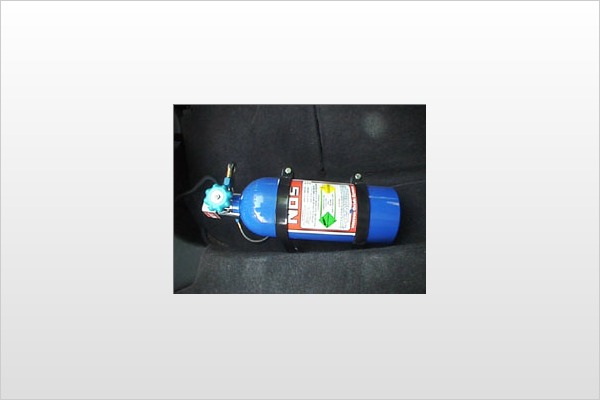
Nitrous oxide, and its relationship to engine performance, is probably the single most misunderstood component of today's automotive aftermarket. The myths and misinformation surrounding this gaseous substance could easily supply plot lines for an entire season of "C.S.I. Miami." Rather than getting caught up in all the hype, we'll begin by taking a simple, straightforward look at how nitrous oxide increases horsepower in an internal combustion engine. Then we'll talk about different methods of installing nitrous oxide on a vehicle; finally we'll address, and dispel, some of the rumors relating to this oft-maligned gas.
When nitrous oxide is present in an engine's combustion chamber, it greatly increases the amount of oxygen that can be burned to produce horsepower. Normally, oxygen makes up about 20 percent of the earth's atmosphere (with increasingly less oxygen at higher altitudes). This means that about 20 percent of the average intake charge is also made up of oxygen, and it is this amount that combines with vehicle fuel to produce combustion. But when nitrous oxide is introduced to the combustion chamber, the percentage of oxygen rises dramatically and allows for substantially more fuel to be used to produce a significantly more powerful explosion. This situation is similar to the one created by using a turbocharger or supercharger--the end result is a higher concentration of oxygen and fuel within the combustion chamber. The only difference is that instead of increasing the volume of air entering the combustion chamber, which is what a turbo or supercharger does, nitrous oxide alters the content of the air entering the combustion chamber; specifically, the oxygen content.
An interesting side effect of using nitrous oxide is the cooling effect it has on intake temperatures. When released from a pressurized container, nitrous oxide drops to around minus 125 degrees, which can cool the overall intake charge by up to 75 degrees, resulting in even more horsepower.
So how does one safely and effectively utilize nitrous oxide for horsepower gains? Thankfully, the ability to accomplish this has improved dramatically since the '40s when the magic of nitrous oxide was first discovered by hot rodders. Early nitrous systems were primitive and inefficient, often resulting in the destruction of engines and giving nitrous a reputation for "blowing things up," a reputation it still carries today.
Currently there are several aftermarket companies that specialize in adapting nitrous oxide for use on automobiles, but the best known of these is Nitrous Oxide Systems, or NOS, located in Costa Mesa, Calif. (nosnitrous.com). This company offers a wide range of nitrous oxide kits, but they can be broken down into two major categories: plate/carb and direct-port systems. The plate/carb design is the less expensive and easier to install kit that uses a single nozzle mounted in the intake system. The direct-port systems are more elaborate (and expensive) and include a nozzle for each cylinder to assure a more complete and efficient distribution of nitrous oxide gas. The prices on these systems range from approximately $500 to $1,000, which is a bargain considering the potential performance gains. For instance, an inexpensive plate/carb system can add 75 horsepower and may add as much as 150 horsepower. The top level, direct port-type systems can add as much as 1,000 horsepower.
Nitrous Oxide Myths
1. "I'm not using nitrous, that stuff'll blow up my engine!" While nitrous oxide has the potential to cause engine damage, it can provide years of safe and effective horsepower gains if installed and operated properly. Obviously, an expert on how to utilize nitrous oxide should be consulted before a kit is installed.
2. "How can my stock engine deal with the additional horsepower?" There are no guarantees when increasing engine performance above the manufacturer's specifications. However, most manufacturers have a "safety margin" designed into their engines that allows for increases in horsepower with no detrimental effects. Also, because the use of nitrous oxide is driver controlled, its exposure to your engine occurs when desired only, allowing the engine to operate under normal conditions most of the time.
3. "Is it legal to use nitrous oxide?" Yes, as long as the components have a certification number. However, an irritated or uninformed police officer may still write a ticket if he sees a nitrous oxide container. It is then up to the individual to appear in court and prove the system's legality.
4. "What if the bottle blows up?!" As mentioned earlier, nitrous oxide itself is not flammable. It does contain a high amount of oxygen which, when combined with fuel, causes a more rapid and powerful explosion.
This column is not meant to endorse the use of nitrous oxide because its advantages will likely appeal to a narrow range of automotive enthusiasts. The concept of regularly filling a container with nitrous oxide just to get extra bursts of speed goes beyond the average driver's tolerance level. At the same time, nitrous oxide should not be dismissed as a risky or primitive performance modification used by speed freaks (certain characters from "The Road Warrior" movie not withstanding). Its cost, ease of use, and real-world performance gains make it a viable option to fulfill your need for speed.